The Thermal Data
Moving on from the restriction test bench the HWLabs 360GTS X-Flow was loaded into the thermal test chamber for a series of 12 tests – consisting of 3 flow rates for Push/Pull and a single flow rate for Push Only, each having 3 different fan rpm speeds tested.
Below is the final data results gathered from at least 5 data logging runs at each flow rate and fan rpm combination. The most stable 15 minute period from each logging run was used and then averaged with the other runs to obtain the data for the table below. A total of 16 temperature sensors were used in the thermal test chamber (8 air in, 2 air out, 3 water in, 3 water out) each take a reading every second and logged via a CrystalFontz unit. The data in the table below is the averaged results of the logging runs which has then been used to create all the plots and tables there-after.
The performance metric of critical importance is the delta between the warm coolant temperature in and the cold ambient air temperature in to the radiator. Given that the system is well insulated and in equilibrium and we know the heat input to the system then we can also calculate a very important number – that is the amount of power required to raise the coolant temperature 1C (or 10C which is more useful reference point).
Let’s take a look at the Delta T results from the tests.
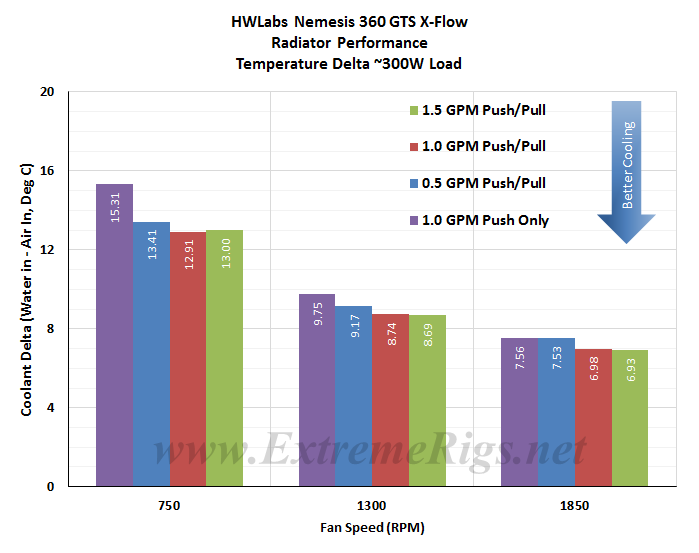
Note that the extrapolation of the curve in the plot format is much more sensitive to error than in between the tested range.
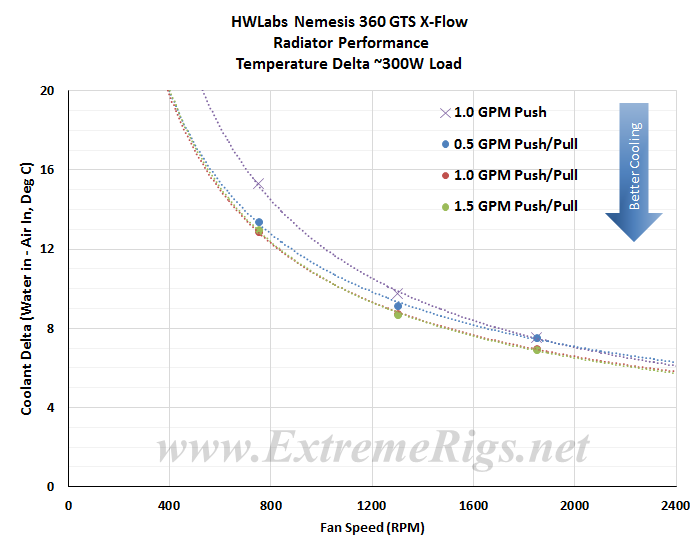 We’re not too concerned about the actual delta numbers here, more so if a trend pattern between fan speeds is occurring. It’s interesting to see the Push Only which is at 1.0 gpm draw closer to the 0.5 gpm Push/Pull as the fan speeds increase.
We’re not too concerned about the actual delta numbers here, more so if a trend pattern between fan speeds is occurring. It’s interesting to see the Push Only which is at 1.0 gpm draw closer to the 0.5 gpm Push/Pull as the fan speeds increase.
Delta T results (as above) is not always helpful when thinking about how many radiators you would need to cool your system. Instead it’s more useful to know the delta/W, or more usefully, the inverse metric of W/delta C. The metric plotted below tells us how many watts are dissipated by the radiator when the coolant rises 10C above ambient temperatures. (W/10 Delta T):
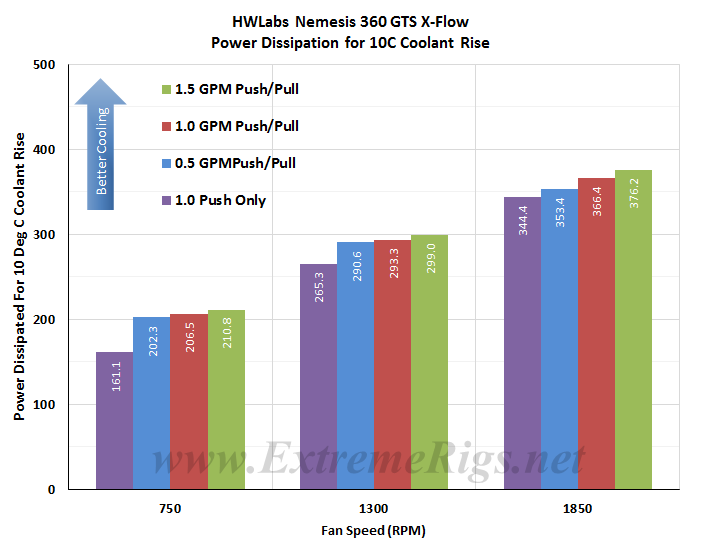 As expected increasing airflow through the radiator is the primary determinant in changing the radiators performance. The lack of variance between flow rates indicates the GTS X-Flow is very well tuned for low flow rates and any increase is not adding much performance benefit whatsoever.
As expected increasing airflow through the radiator is the primary determinant in changing the radiators performance. The lack of variance between flow rates indicates the GTS X-Flow is very well tuned for low flow rates and any increase is not adding much performance benefit whatsoever.
The same data can now be plotted as a curve so that an end user can interpolate their own fan speed. Note that the extrapolation of the curve is much more sensitive to error than in between the tested range.
Let’s exclude the push data for now and come back to it:
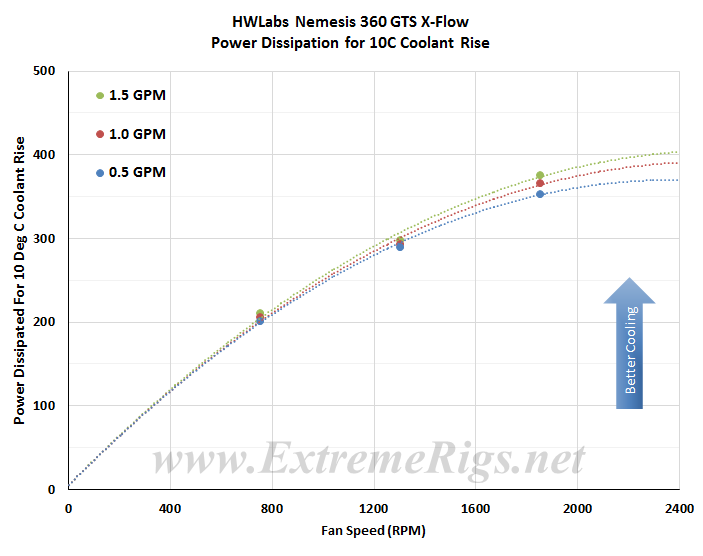 The tightly bunched lines are evidence that increasing flow rate is yielding little benefit in performance. With each flow rate curve flattening out at the high fan speeds we conclude that 400 Watts is about the limit of heat dissipation while maintaining a 10°C Delta. With 6 six fans at 2400 rpm this would be excessively loud and would actually have worse performance than A Push Only set-up as seen in the next plot. Therefore we think the sweet spot for Push/Pull is around 1300rpm for a 300Watt dissipation level.
The tightly bunched lines are evidence that increasing flow rate is yielding little benefit in performance. With each flow rate curve flattening out at the high fan speeds we conclude that 400 Watts is about the limit of heat dissipation while maintaining a 10°C Delta. With 6 six fans at 2400 rpm this would be excessively loud and would actually have worse performance than A Push Only set-up as seen in the next plot. Therefore we think the sweet spot for Push/Pull is around 1300rpm for a 300Watt dissipation level.
If we now come back to the Push Only data it’s good to compare the Push to Push/Pull data in an “apples to apples” fashion by only looking at the 1GPM data:
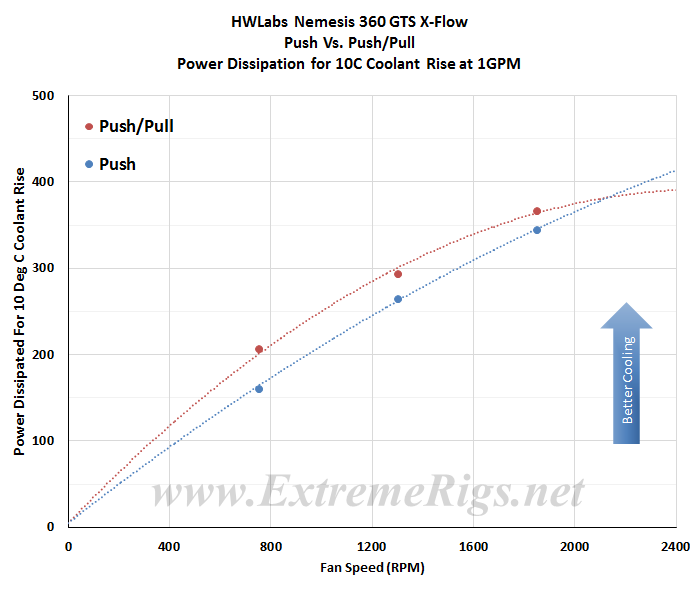 Push only gives around 87% (averaged) of the performance of the Push/Pull 1.0 gpm test results on this radiator. That average may not be a good representation of the comparisons however as we recorded a difference of 78% at 750 rpm and as fan speeds increased the comparison drew closer together: 90% at 1300rpm and 94% at 1850rpm. The trend line indicates the Push Only would have beaten Push/Pull at around 2100rpm -however this is most likely just because our extrapolated lines have some inaccuracies when you go beyond the range tested. There is no reason for push/pull to ever perform worse than push – at some airflow they will essentially become the same and “max out”.
Push only gives around 87% (averaged) of the performance of the Push/Pull 1.0 gpm test results on this radiator. That average may not be a good representation of the comparisons however as we recorded a difference of 78% at 750 rpm and as fan speeds increased the comparison drew closer together: 90% at 1300rpm and 94% at 1850rpm. The trend line indicates the Push Only would have beaten Push/Pull at around 2100rpm -however this is most likely just because our extrapolated lines have some inaccuracies when you go beyond the range tested. There is no reason for push/pull to ever perform worse than push – at some airflow they will essentially become the same and “max out”.
In this next plot all three Push/Pull results at each flow rate were averaged to produce one curve and we compared the results against the best and worst performing of all the 360 rads we have tested.. Averaging reduces test error of course so this helps further to be sure of our data and is more useful therefore for comparing to other radiators.
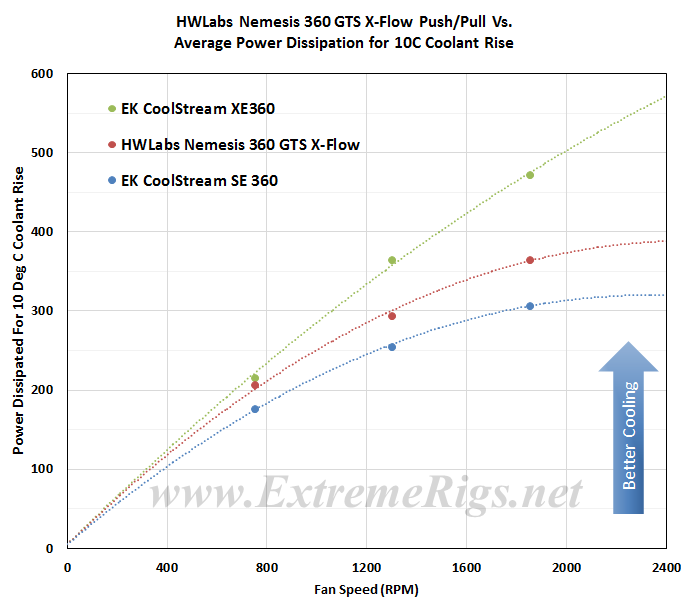 To give some perspective, The EK XE 360 is twice as thick as the GTS X-Flow (and the EK SE) and was a performance beast which placed first in nearly every thermal test we conducted on it. The comparison radiators were chosen as they are the current best and worst performers of our entire 360mm test group.
To give some perspective, The EK XE 360 is twice as thick as the GTS X-Flow (and the EK SE) and was a performance beast which placed first in nearly every thermal test we conducted on it. The comparison radiators were chosen as they are the current best and worst performers of our entire 360mm test group.
Perhaps it is fairer to compare the GTS X-Flow only against other slim radiators.
Firstly the Push Only Slims at 1.0 GPM
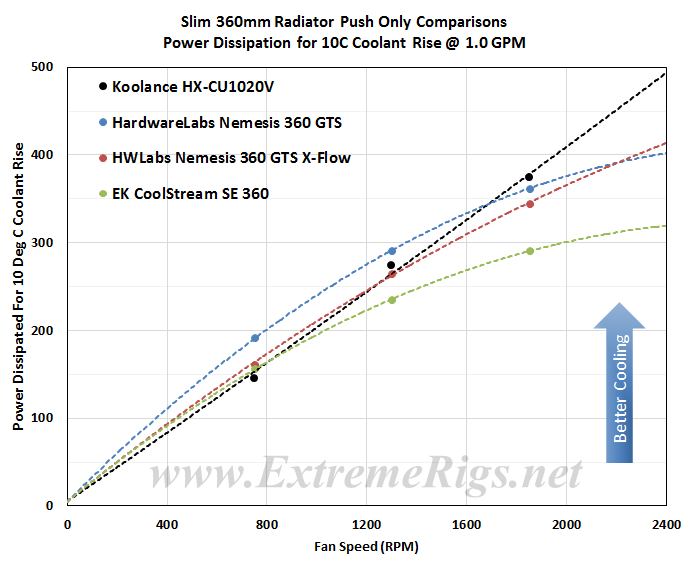 In Push Only, which we believe is the most likely installation scenario for a slim rad, the performance of the GTS X-Flow was weaker than the regular version of the GTS at all our test data points.
In Push Only, which we believe is the most likely installation scenario for a slim rad, the performance of the GTS X-Flow was weaker than the regular version of the GTS at all our test data points.
And the Push/Pull Slim rad comparisons:
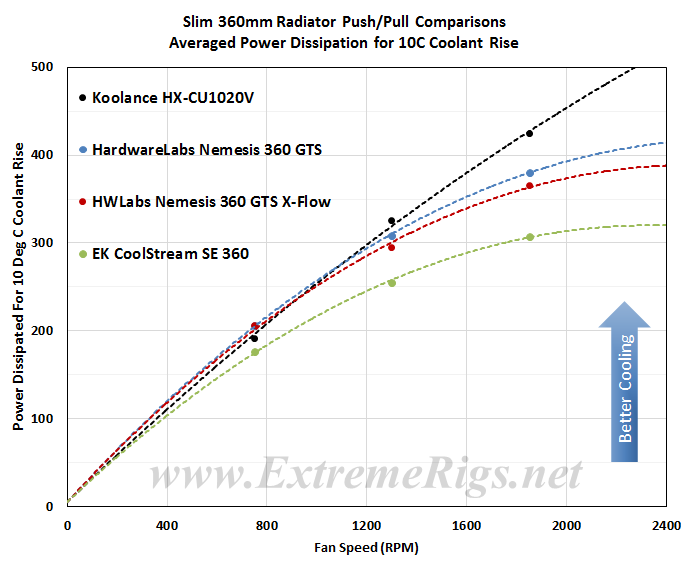 We clearly see one rad which is weaker than the rest, and one which is better at high rpm in Push/Pull. The fact that the GTS X-Flow is so competitive is fantastic as it means you can have the benefits of a X-Flow radiator design with easier/cleaner tubing runs without any significant loss of performance.
We clearly see one rad which is weaker than the rest, and one which is better at high rpm in Push/Pull. The fact that the GTS X-Flow is so competitive is fantastic as it means you can have the benefits of a X-Flow radiator design with easier/cleaner tubing runs without any significant loss of performance.
Now let’s analyze that data some more…








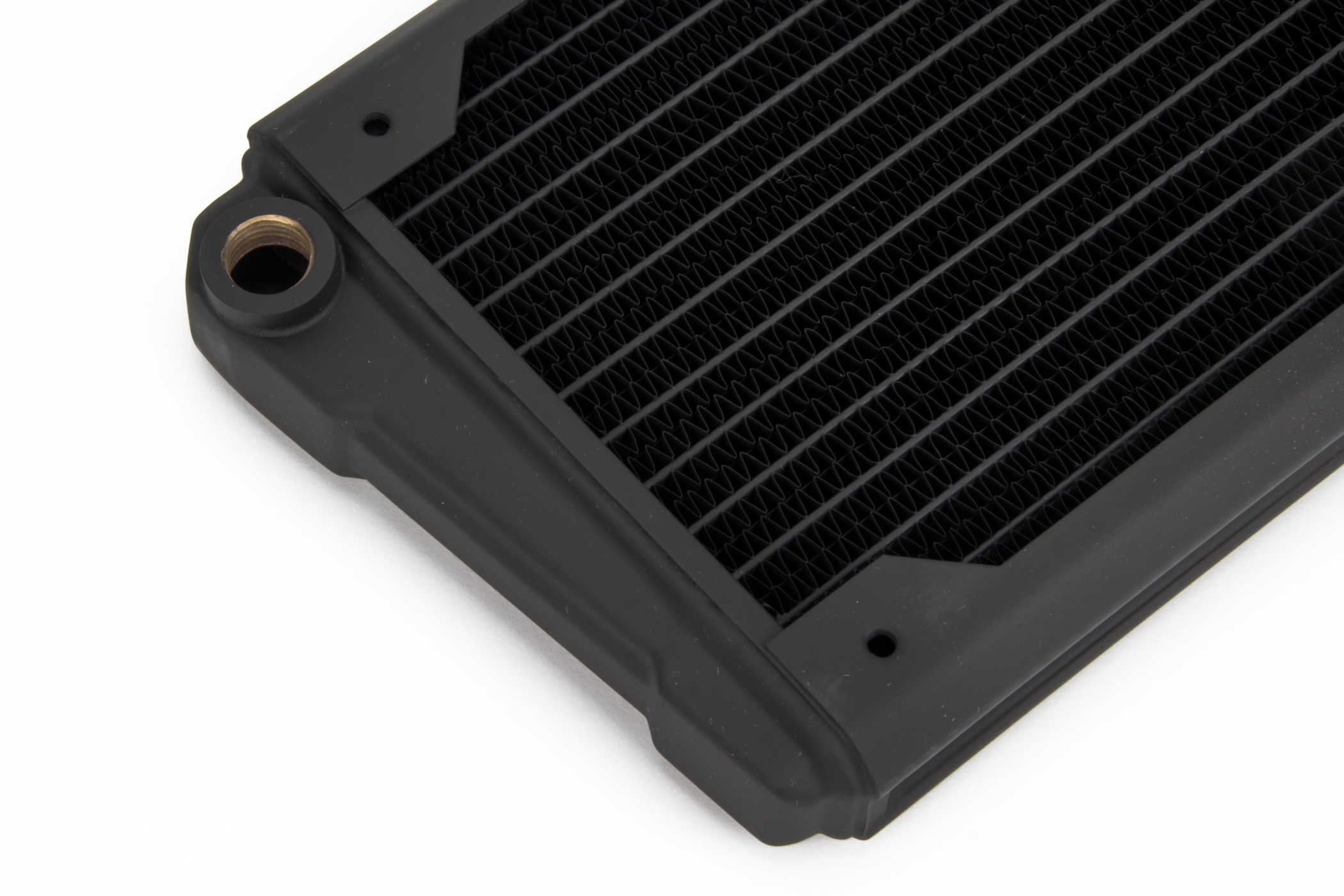
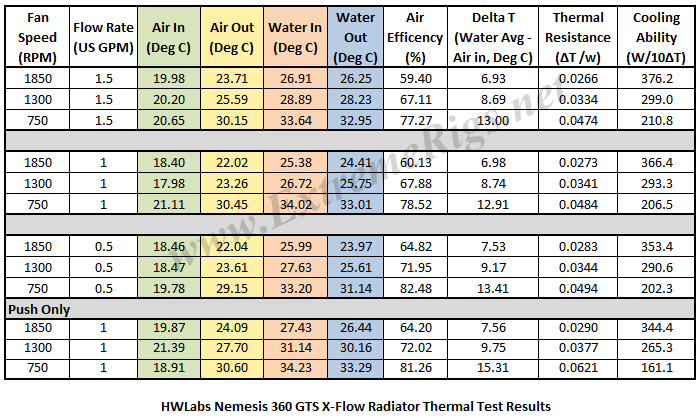



Thank you (again) for doing such a great review. I love these data driven reviews that you guys do.
I recently bought a Black Ice Nemesis 360 GTS U-Flow and Black Ice Nemesis 240 GTS U-Flow. There are in a single loop together with an EK Supremacy EVO X99 and two EK Titan X waterblocks (the GPUs in parallel). So a fairly medium / high flow restriction loop. I also have a dual D5 pump, but as I am currently in the process of tuning my rig I only have 1 pump running. The Flow rate with one D5 on maximum is absolutely fine. The D5 on maximum is also very quiet, so I am lucky there. When I get both pumps up and running I will be able to run the D5s at maybe 40% power each, I imagine, and get satisfactory flow with this set up.
Point being: given this setup I am glad that I have the extra performance of the U-Flow compared to the XFlow. As these radiators are super thin, I am less convinced at the usefulness of push/pull. If you have space for push/pull you could have gone for a 60mm thick rad surely. Also the extra length of the XFlow – as you point out – could cause problems.
Overall I think Hardware Labs radiators are terrific products. Only complaint is the 28mm screw length: I had to buy and then wait for 30mm M4 screws to be delivered to me which held up the whole build.
[…] HWLabs Nemesis 360 GTS X-Flow 360mm Radiator Review […]
Comments are closed.